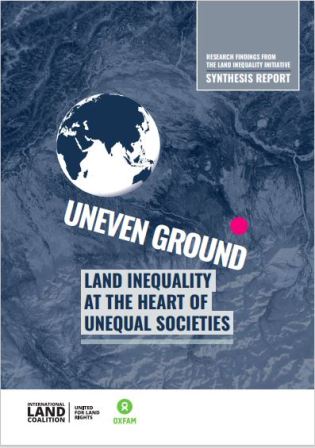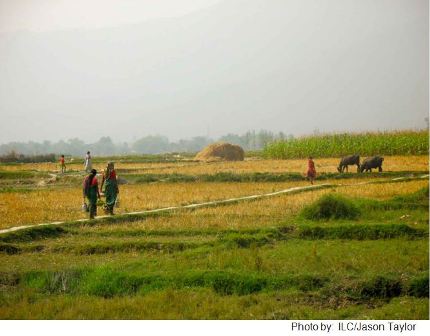Women’s Right to Land: Foundation for a Better Tomorrow
Regional actors must recognise the benefits of women owning land and their contributions to their families and communities.
In many Asian countries, women’s access to and decision-making power over land and natural resources, ownership, use, and tenure security is limited and often hindered by existing social norms and patriarchal attitudes. This is further exacerbated by restrictive policy instruments and legal frameworks and/or weak law enforcement at the local and national levels. Land rights offer multiple pathways for women in rural areas to sustain their livelihoods, enhance their social, economic and political autonomy, and reduce their vulnerability to marginalisation. Hence, putting those who live on and from the land, such as women and girls, at the centre of decision-making is important.
resources, ownership, use, and tenure security is limited and often hindered by existing social norms and patriarchal attitudes. This is further exacerbated by restrictive policy instruments and legal frameworks and/or weak law enforcement at the local and national levels. Land rights offer multiple pathways for women in rural areas to sustain their livelihoods, enhance their social, economic and political autonomy, and reduce their vulnerability to marginalisation. Hence, putting those who live on and from the land, such as women and girls, at the centre of decision-making is important.
Secure land rights for women and girls are linked to increased women’s leadership and autonomy, enhanced economic opportunities, better social security, safety, and dignified societal standing. Improved income, better child nutrition, higher educational attainment for girls, enhanced women’s agency, and more sustainable use of natural resources contribute to developing healthy and resilient households and communities.
The intersecting identities of women, such as indigenous, young, rural, and urban poor, among others, define the importance of their access to land and natural resources. Indigenous women, for example, rely on the traditional knowledge passed down for generations to sustain their daily life. Such knowledge, at the same time, allows indigenous women to conserve both their land and territories and their culture.
Context of Women’s Land Rights in South Asia
Bangladesh, Nepal and India are three geographies that exemplify climate and land inequalities. According to a study by the International Land Coalition (ILC), South Asia and Latin America exhibit the highest levels of agricultural land inequality, with the top 10% of landowners capturing up to 75% of farmland and the bottom 50% owning less than 2%.
In Bangladesh, for example, strict inheritance laws based on religion-based personal rules prevent women from owning land and property. Women who are single, divorced, or household heads are also deprived of inheritance property, and in addition, there is a strong tendency for households not to put women’s names on the land deed.
Climate change has also affected the lives of communities in coastal areas like the Sundarbans––a vast mangrove forest spanning about 10,000 sqkm in parts of Bangladesh and the Indian state of West Bengal. Extreme weather conditions and rising sea levels have a debilitating effect on the Sundarbans’ agricultural land, making women farmers more susceptible to crop failures and natural disasters.
In India, land ownership is highly skewed in favour of men, with women constituting barely 14% of all landowners. Lack of legal ownership and access to natural resources contribute to women’s vulnerability to climate change, making it harder for them to access government compensation and relief measures for crop failure.
Nepal has adopted legal reforms that allow women and girls to enjoy equal opportunities to own or inherit land as men. The 2015 Constitution notably introduced the prohibition of gender-based discrimination, equal inheritance and property rights for both women and men. Despite such progressive policies, women and young people in rural areas are socially disadvantaged. The marginalisation manifests in multiple forms, such as caste, class and culture, making women feel less secure than men in their tenure security.
 There is a vast gap between policies and practices due to the need for more effective law enforcement. Currently, the Joint Land Ownership scheme is being integrated into mainstream policies and practices that mandate the government to issue land certificates in the name of both husband and wife and provide land to landless communities, including the Dalits (lowest-caste hierarchy or known as untouchables), and informal settlers.
There is a vast gap between policies and practices due to the need for more effective law enforcement. Currently, the Joint Land Ownership scheme is being integrated into mainstream policies and practices that mandate the government to issue land certificates in the name of both husband and wife and provide land to landless communities, including the Dalits (lowest-caste hierarchy or known as untouchables), and informal settlers.
The impact of climate change is hard-hitting for communities in the three countries, and women are the ones who bear the brunt the most. On top of caring for their families, women often do the physical work of collecting water and other resources from faraway sources, toiling on their farms for long periods, and generally working harder to sustain their income. Moreover, agriculture in the three countries is primarily rainfed, which makes it susceptible to extreme weather and unpredictable rainfall.
Why Should Governments Talk About Land Rights for Women?
There is a need for women to have stronger literacy on land rights and the opportunities that come with the enjoyment of such a right. Women from marginalised communities rarely engage in policy-making at the local or national level. They rarely access the services of local land offices, which contributes to their lower level of land literacy.
Initiatives brought by civil society or non-profit organisations to raise awareness of land rights among women remain a stepping stone towards achieving effective policy advocacy. Building confidence and communication skills among women can strengthen their leadership abilities and amplify their voices, especially when they must speak up to local-level government officials such as land administration offices, agricultural welfare offices, and more.
In early April 2023, members of ILC in Nepal, Bangladesh and India will co-organise a regional policy dialogue that focuses on women’s land rights and their relevance in strengthening the capacity of local communities in climate change adaptation. The event is co-organised with the Nepal Ministry of Land Management, Cooperatives, and Poverty Alleviation and supported by the Stockholm Environment Institute (SEI). It seeks to catalyse and stimulate dialogue between civil society, government bodies, and those impacted the most by climate change and weak land tenure security to create meaningful participation in finding climate solutions from the ground up. Amid the deepening climate crisis, it is high time for regional actors and, more importantly, governments to become more aware of the benefits of women owning land and recognise them as farmers, producers and their contributions to their families and communities.
(cover photo by ILC/Jason Taylor)
